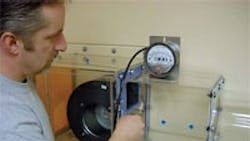Manometers or pressure gauges have been used to measure air pressures for more than 200 years. The fathers of our industry used these gauges to learn about the mysteries of fans and duct systems.
We use these same instruments (Although a little updated) to reveal similar mysteries about the systems we install and service today. Measuring pressure is just as critical in our time.
Without testing and using the right tools, many technicians make incorrect assumptions about air capacities and performance related to the HVAC systems on which they work.
When you measure system static pressure, you’ll discover a long list of duct defects and other problems that cause poor system performance. By measuring actual operating conditions, you’ll be able to offer real solutions to many existing comfort problems that are overlooked by your competitors.
Recommended Instruments
Having the right tools is essential. Fortunately, pressure measurement tools are fairly inexpensive. A complete static pressure kit including the necessary accessories can be purchased for less than $200.
A good quality manometer is inexpensive and is a reliable static pressure testing instrument. For residential and light commercial system testing, analog instruments should have a range from 0-1-in. w.c. Most digital gauges should be rated from 0- to 5-in. Typical resolution should be .01-in. w.c. and have an accuracy of +/- 2%. Low quality instruments or ones with too broad of a test range, or ones with a single pressure port will make testing difficult and you may end up discouraged.
National Comfort Institute recommends the Dwyer Magnehelic gauge, model 2001 AV PORT, or any good quality digital manometer plus the accessories listed below:
- the manometer of your choice
- carrying case
- two 3-ft. lengths of 3/16-in. I.D. rubber or neoprene tubing
- at least one Dwyer Model A-303 Static Pressure Tip
- 3/8-in. bullet tip drill bit
- a 1-in. O.D. x 12-in. I.D. x 4 1/2-in. long sheath to use over the drill bit
- 3/8-in. plastic hole plugs.
System Airflow Capacities
We measure static pressure to interpret airflow in a system. It works similar to blood pressure, the higher the pressure on the heart, the less blood it can move. With fans, the higher the static pressure in the system, the less air it can move.
Most manufacturers’ engineering manuals rate airflow in furnaces, fan coils, and air handlers based on Total External Static Pressure (TESP). A typical furnace is designed to operate at a maximum of .50-in. w.c. If there is more than .50-in. of Total External Static Pressure, the fan is unable to move the required 400 CFM per ton.
Check the fan capacity of the residential furnaces and air handlers you select carefully, the maximum rated pressure capacities may range from .20- to .90-in. This means some fans have four times the pressure capacity of others.
Bottom line: Believe it or not there is equipment manufactured and sold today that is unable to deliver 400 CFM per ton with only the matched filter and coil installed, much less a duct system.
So, how well is the last system you installed working? Are you sure?
Review your engineering data carefully. Proper equipment selection is your responsibility, not the manufacturer’s or distributors. Many rated equipment combinations have extremely high efficiency ratings but do not have fan capacity. To meet the government demands for higher efficiency, many manufacturers have lowered fan sizes to decrease power consumption, and yet increased the rows of fins per inch in coils to get the appearance of increased efficiency. The problem is the net effect is equipment that has very low airflow capacity. If you’re not careful, you’ll be loser in this game of politics.
Static Pressure Testing Overview
To determine total external static pressure (TESP) of a furnace you first measure the supply (+) pressure near the discharge of the unit, between the furnace and the coil. Then you measure the return (-) pressure near the inlet of the unit, often between the filter and the furnace. Add the two readings together to find the system’s total external static pressure.
When measuring heat pump air handler static pressure without an external coil, measure the supply (+) static pressure at the discharge of the unit, and the return (-) pressure before the internal coil. The total of these two readings are the system’s total external static pressure.
Hint: When adding the positive and negative pressures together. Disregard the + and – signs. These only indicate type of pressure measured.
Compare the measured TESP to the rated pressure capacity of the unit (normally found on the nameplate data). The rule is if the TESP is less than the nameplate data, the airflow will be at or above 400 CFM per ton with the fan set on high speed. But if the measured pressure exceeds the rated pressure the airflow will may lower than 400 CFM per ton.
Read the manufacturer’s blower performance data to interpret what the fan is really doing under measured operating conditions. Remember also, that fan capacity can vary depending on the voltage at which a fan is operating, the cleanliness of a fan, or the condition of a blower motor, or duct configurations near the fan.
Next month: Steps required to measure total external static pressure.
About the Author
Rob 'Doc' Falke
President
Rob “Doc” Falke serves the industry as president of National Comfort Institute an HVAC-based training company and membership organization. If you're an HVAC contractor or technician interested in a building pressure measurement procedure, contact Doc at [email protected] or call him at 800-633-7058. Go to NCI’s website at NationalComfortInstitute.com for free information, articles and downloads.
